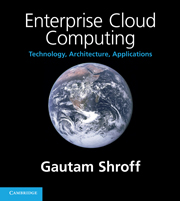Book contents
- Frontmatter
- Contents
- Preface
- List of abbreviations
- Part I Computing platforms
- Part II Cloud platforms
- Part III Cloud technologies
- Part IV Cloud development
- Chapter 10 Data in the cloud
- Chapter 11 MapReduce and extensions
- Chapter 12 Dev 2.0 platforms
- Part V Software architecture
- Part VI Enterprise cloud computing
- References
- Index
Chapter 12 - Dev 2.0 platforms
Published online by Cambridge University Press: 06 December 2010
- Frontmatter
- Contents
- Preface
- List of abbreviations
- Part I Computing platforms
- Part II Cloud platforms
- Part III Cloud technologies
- Part IV Cloud development
- Chapter 10 Data in the cloud
- Chapter 11 MapReduce and extensions
- Chapter 12 Dev 2.0 platforms
- Part V Software architecture
- Part VI Enterprise cloud computing
- References
- Index
Summary
The cloud development paradigms covered so far have focused on scale, i.e. how data and computations can be organized in a very large distributed environment where hardware and network failures are to be expected as a matter of course rather than as exceptions. As we pointed out during our discussion on cloud economics in Chapter 6, PaaS clouds additionally offer the promise of improving development productivity while also catering for large volumes.
We now turn our attention to enterprise applications that may not necessarily require large volume computing, but which nevertheless account for a very large fraction of software development efforts: These are the numerous inter-organizational workflow and transaction-processing applications that enterprise IT departments spend significant development and maintenance efforts on. The computational requirements of this class of applications are typically an order of magnitude less than that of mission-critical transaction-processing or large-scale analytics applications. At the same time these constitute an important class of applications because of the sheer number of such systems being used. In Chapter 13 we shall examine in more detail the functionalities typically covered by such applications within the overall context of enterprise software needs.
Technically this class of applications can be described as ‘forms-based transaction-processing and workflow systems using a relational database,’ restricted also by scale; so we exclude those where very high transaction and data volumes need to be supported.
- Type
- Chapter
- Information
- Enterprise Cloud ComputingTechnology, Architecture, Applications, pp. 144 - 158Publisher: Cambridge University PressPrint publication year: 2010

